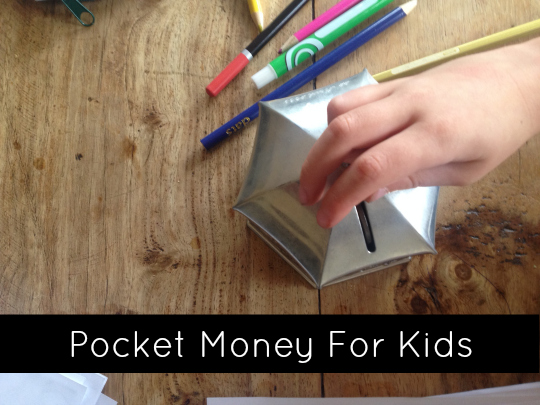EDIT: If you would like to see how we track the money we give the kids and download a free excel spreadsheet template, you can do so here – How to keep track of the kids’ pocket money.
When I have posted about the allocation for jobs for our kids, I always have readers ask me about how much, if any pocket money, that we give the kids for doing these jobs. Our kids do get pocket money, however their is no relationship between their jobs and their pocket money.
When we decided that we would give pocket money, I did quite a bit of research. I wanted to obtain an understanding of what differing models were out there and find one that would fit in with our parenting style.
As with most parenting information, it ended up not being one sole source that I used for our pocket money model, but a hybrid of what I liked best from those that I had read about. In short this was what we came up with:
- We would hand out pocket money on a weekly basis.
- We would have differing amounts for the different ages of the children.
- Once at school each child would get a pocket money increase.
- Once they reach secondary school, they receive another significant increase however it needs to cover any lunches they want to buy, mobile phone bill presents for friends etc.
- The pre-secondary children can spend the money only once they reach $20.
- The children can choose what to spend their money on.
- Pocket money is not related to their allocated jobs around the house.
The last point seems to garner most interest from people I talked to about it. We made this decision for two key reasons:
Part of the Family
As members of the family, we feel the children need to contribute to the maintenance and upkeep of the household to enable it to keep running smoothly. Being responsible for specific tasks allows them to better appreciate the volume of work that mum and dad do for them. Neither mum nor dad receives payment for this work around the house; it is done purely for the love of our family.
Boundaries for payments
If we paid the pocket money in relationship with the jobs that the kids do, what happens when we want them to start doing more? We have recently increased the jobs that the kids do, in line with their capabilities. At no point in the revision of duties was money discussed. The key point of the discussion was around each family member having a responsibility to help out around the house.
What happens if I ask the children to do something that isn’t on their current list of jobs? I had heard from other parents of children saying things like “How much will you will pay me to do it?” or saying “No, I don’t get paid to do the that job.”
By not relating the kids jobs to pocket money, this takes away the aforementioned issues. The children receive pocket money simply as their share in the families resources.
What do kids learn from pocket money?
I believe that pocket money provides a fantastic opportunity to give children an introduction to the value of money and financial planning in the following ways:
Saving
By ensuring that they build up their money before the spend it, the instant gratification urge can be tamed. They learn from the immense feeling of satisfaction from having saved up to buy an item that they have really wanted.
Real Life Experience
Even though I had agreed that the children could choose what they spent their money on, I have to admit to initially trying to influence their purchases. I was quickly told by Thinker many years ago, that it was “my money and I get to decide.” He was right. If I was to encourage responsible spending I had to empower them to make their own choices.
In the first year that we started pocket money, this meant that lots of plastic, junky toys were purchased. This was certainly a direct result of me not buying these types of toys for them. But although I had to put up with these toys for a while, letting them buy them actually worked out positively. They eventually worked out for themselves that they weren’t that great after all. They only played with them for a short time, they broke easily, too many small parts were difficult to keep track of and they didn’t really hold their interest.
They then started putting more thought into their purchases. They started setting goals of above $20 to save, because they had a particular item in mind. These items are now rarely toys. Books, cricket gear, a hammock, an umbrella are all recent purchases that they have made. They are always proud to tell people that they bought these things with their own money.
Social Etiquette Lesson
We have discussed with the children that it is impolite to talk about how much pocket money they have or to ask other children about how much they get. We explained that it is the adult equivalent of asking someone how much they earn. Instead of worrying about this, we have emphasised to the children, that they should be grateful for what they do receive and focus on the best way to spend what they have.

